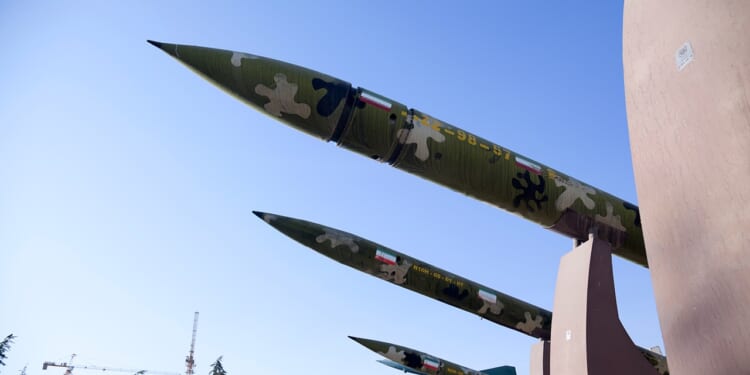If Israel is planning to attack Iran again, likely with US assistance, Tehran is almost certain to retaliate against naval targets in the Persian Gulf.
With a dozen US Air Force KC-135 Stratotankers arriving at Al Udeid Air Base in Doha, Qatar, and Israeli defense officials telling The Jerusalem Post that the Jewish democracy “may need to act again” against the Islamic Republic of Iran, talk abounds in the region that the second phase of the war started in June by Israel against Iran is underway. And while the so-called 12-Day War in June was a limited event, it seems that this next phase is meant to be the final nail in the theocratic regime’s coffin.
Surely Iran’s Islamist rulers understand what is at stake. And while Israel dealt serious blows to the Iranian regime in June under “Operation Rising Lion,” the fact remains that they failed to decapitate the regime. Indeed, Iran still has considerable capabilities at its disposal—capabilities that should give any Israeli and American military leader pause about the efficacy of engaging in an air war against the Islamist regime.
Iran’s small navy was not deployed in the last round of fighting. If this next round is to be the final decapitation of the regime, though, Tehran may decide to deploy all its assets into the fray. One such system is the Ghadr-380, which is an Iranian anti-ship cruise missile developed by the Islamic Revolutionary Guard Corps (IRGC). It was publicly unveiled in February of this year.
The missile is part of Iran’s broader strategy to enhance its asymmetric warfare capabilities, particularly in the Persian Gulf and the Sea of Oman, where it is designed to target enemy warships, including US Navy vessels.
What to Know About the Ghadr-380 Missile
Unveiled with great aplomb by the IRGC in February 2025, the Ghadr-380 is a strategic anti-destroyer cruise missile, land-launched from mobile truck-based systems. Like the other Ghadr missiles that came before it, it appears to be based on Iran’s earlier Paveh series of cruise missiles. However, the Ghadr-380 improves on its predecessors through a dramatically expanded range; if IRGC reports are to be believed, the missile has an effective range of roughly 620 miles (1,000 km), about double that of previous Ghadr systems. The missile relies on a single-launch system operable by one person and deployable from underground silos or bases in under five minutes.
The Ghadr-380 has a slender, cylindrical body with wings and fins for stability. In flight, it produces a bright flame and smoke trail during ascent, transitioning to level cruise once at altitude. It is equipped with smart guidance systems that allow for it to autonomously select routes, altitudes, and directions to evade defenses; it can also be guided to the target until impact.
The system features anti-jamming capabilities to counter enemy electronic warfare, such as from US Navy destroyers. And because these weapons are stored in Iran’s gigantic underground “missile cities,” they are extremely difficult to take out in a preemptive strike; Israeli attempts to do so during Operation Rising Lion appear to have come up short. The underground missile storage facilities enable Iran to rapidly load the missiles onto launcher trucks, which can then be fired from remote locations.
If Israel Attacks Iran Again, Anything Could Happen
IRGC Navy commander, Rear Adm. Alireza Tangsiri described the Ghadr-380 as being able to “create hell for enemy vessels.” And he is likely right. Especially when one considers that the Iranian military is the one supplying most of the missiles and drones that the Houthi Rebels of Yemen are using to wreak havoc on the region, notably Israel, and global shipping. In other words, the region must take care not to discount the Iranian missile threat to ships.
In fact, this is likely one reason why the Americans are deploying their vaunted $13 billion aircraft carrier, the USS Gerald R. Ford, in the Mediterranean Sea rather than placing it, say, in the Arabian Gulf or the Strait of Hormuz, which would make the American carrier vulnerable to this sophisticated weapon.
There have been no significant public updates or additional tests reported since the initial reveal. Suffice it to say that if Israel is going all-in with attacking the regime soon—with likely US assistance to boot—all weapons in Iran’s arsenal will be used to defend the clerical regime. And at least some of these weapons could threaten US and allied warships if the Israelis initiate another attack on Iran.
About the Author: Brandon J. Weichert
Brandon J. Weichert is a senior national security editor at The National Interest. Recently, Weichert became the host of The National Security Hour on America Outloud News and iHeartRadio, where he discusses national security policy every Wednesday at 8pm Eastern. He is also a contributor at Popular Mechanics and has consulted regularly with various government institutions and private organizations on geopolitical issues. Weichert’s writings have appeared in multiple publications, including The Washington Times, National Review, The American Spectator, MSN, The Asia Times, and others. His books include Winning Space: How America Remains a Superpower, Biohacked: China’s Race to Control Life, and The Shadow War: Iran’s Quest for Supremacy. His newest book, A Disaster of Our Own Making: How the West Lost Ukraine is available for purchase wherever books are sold. He can be followed via Twitter @WeTheBrandon.
Image: Shutterstock / saeediex.
















